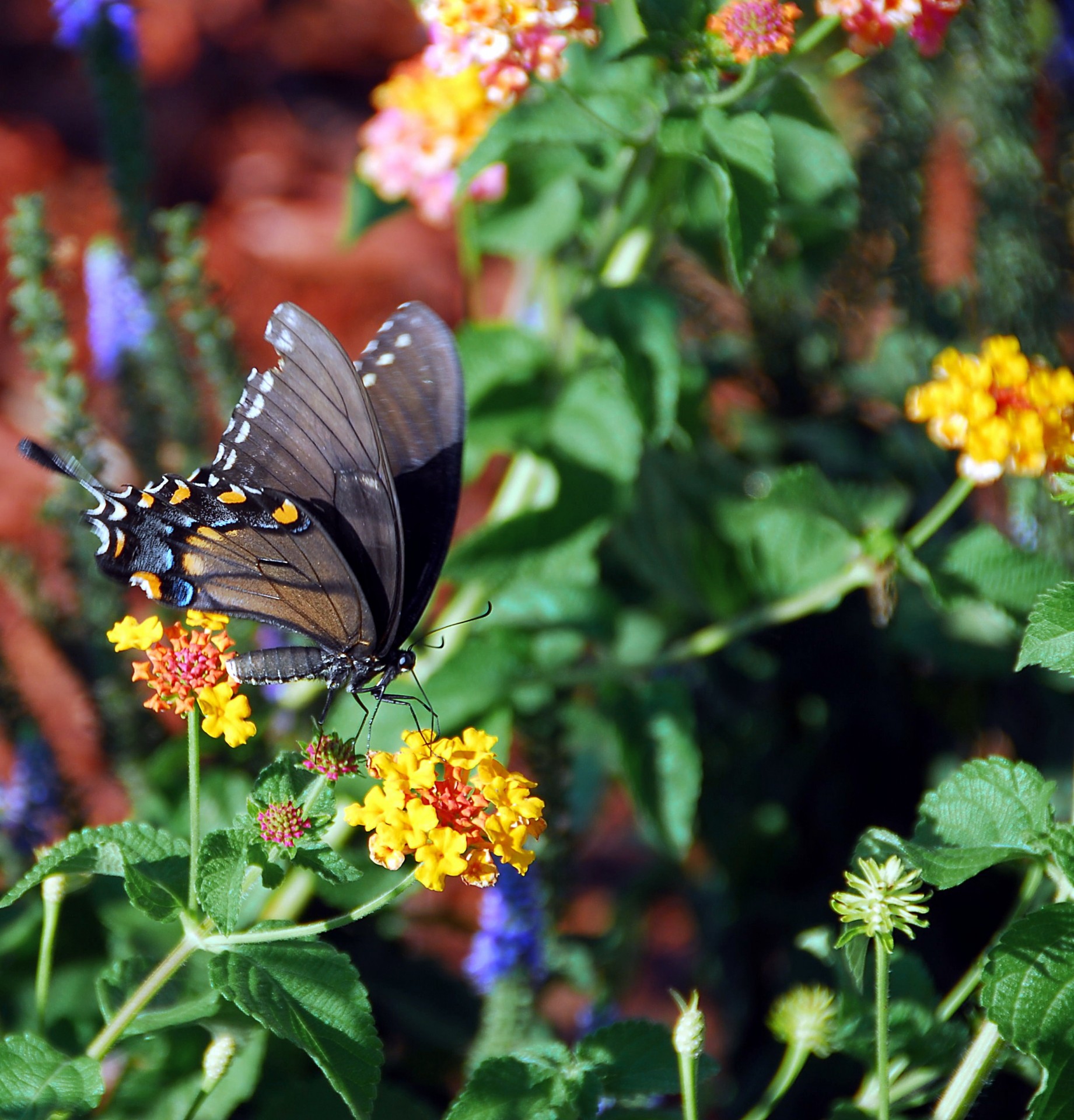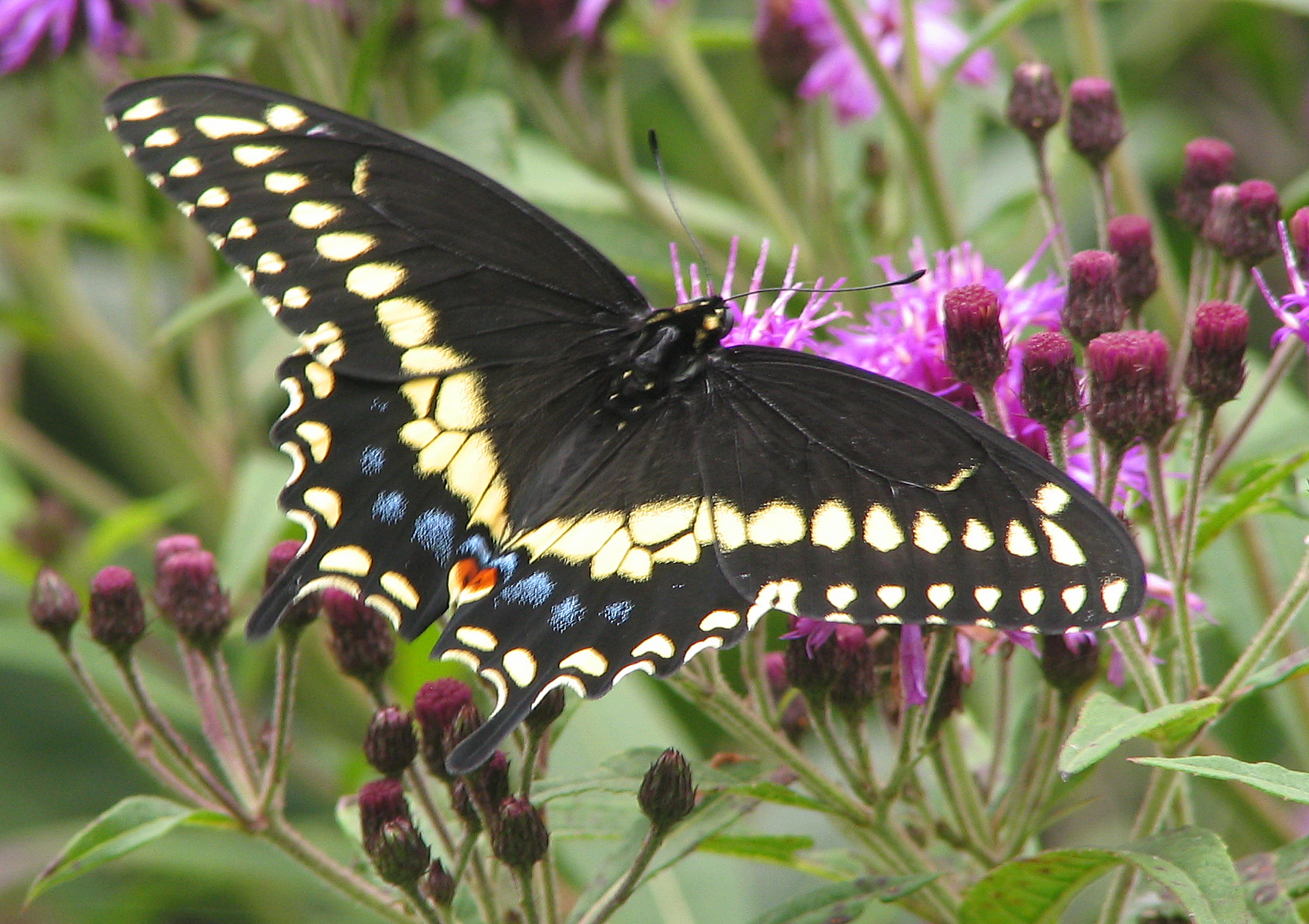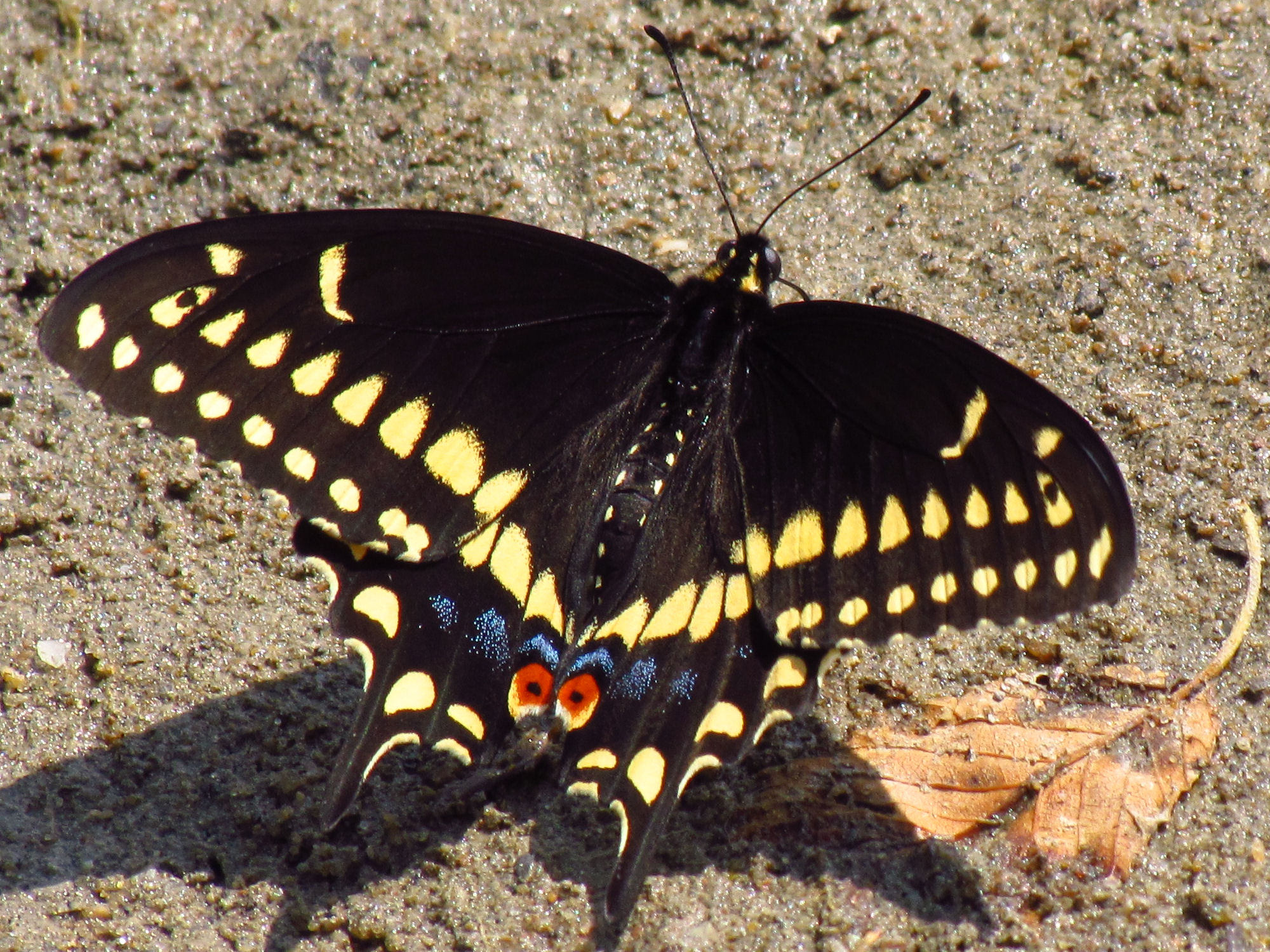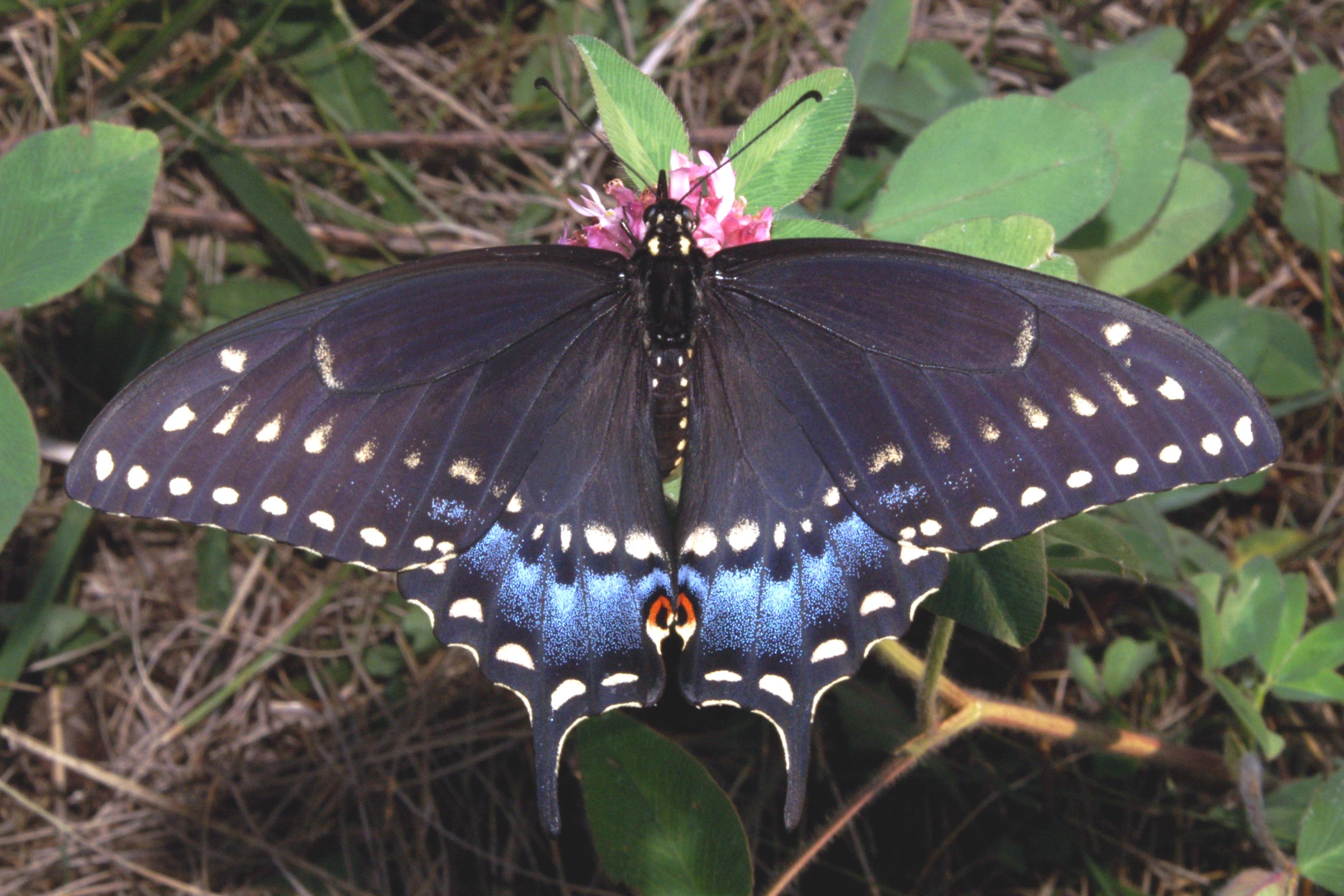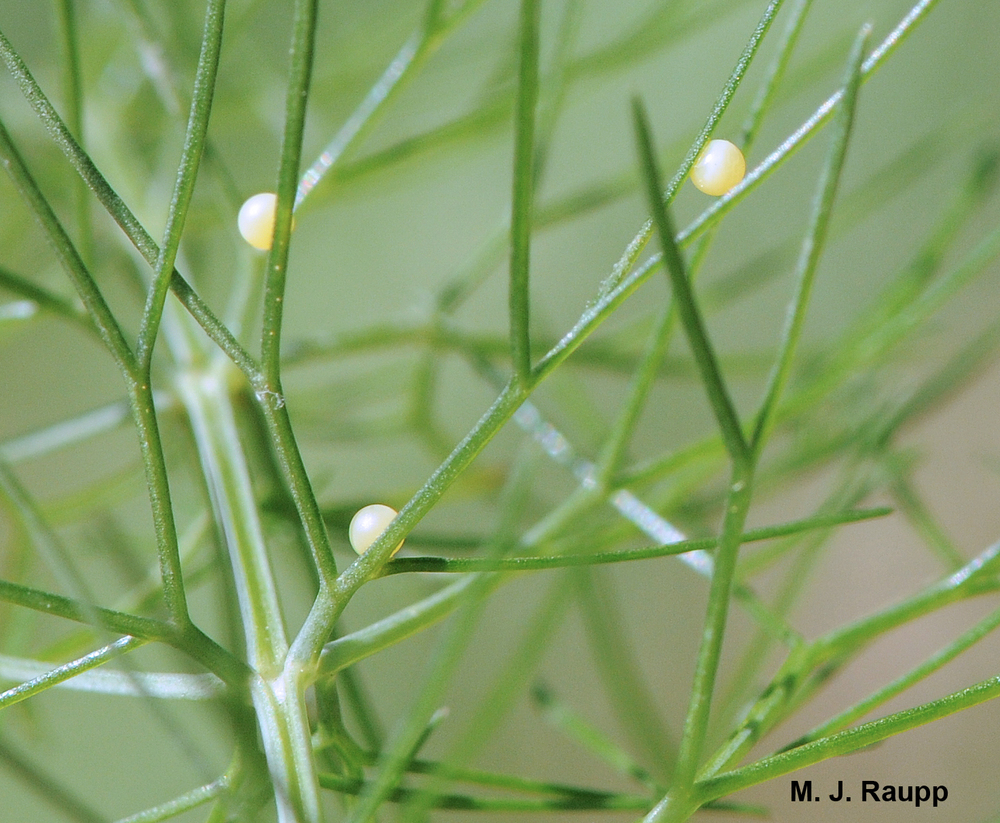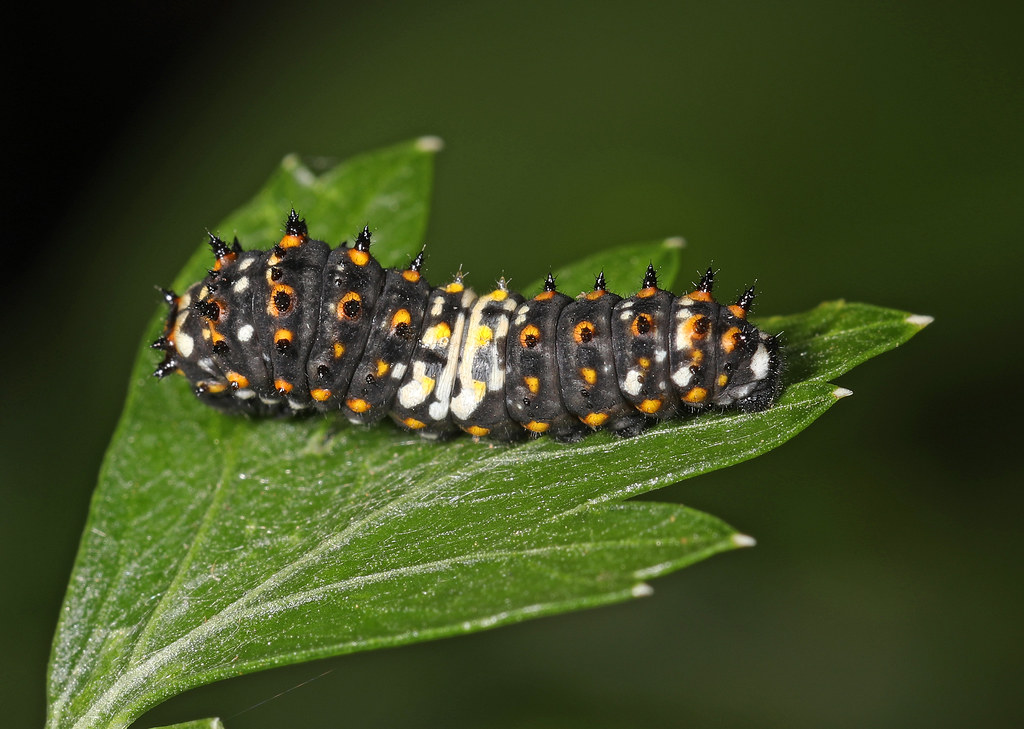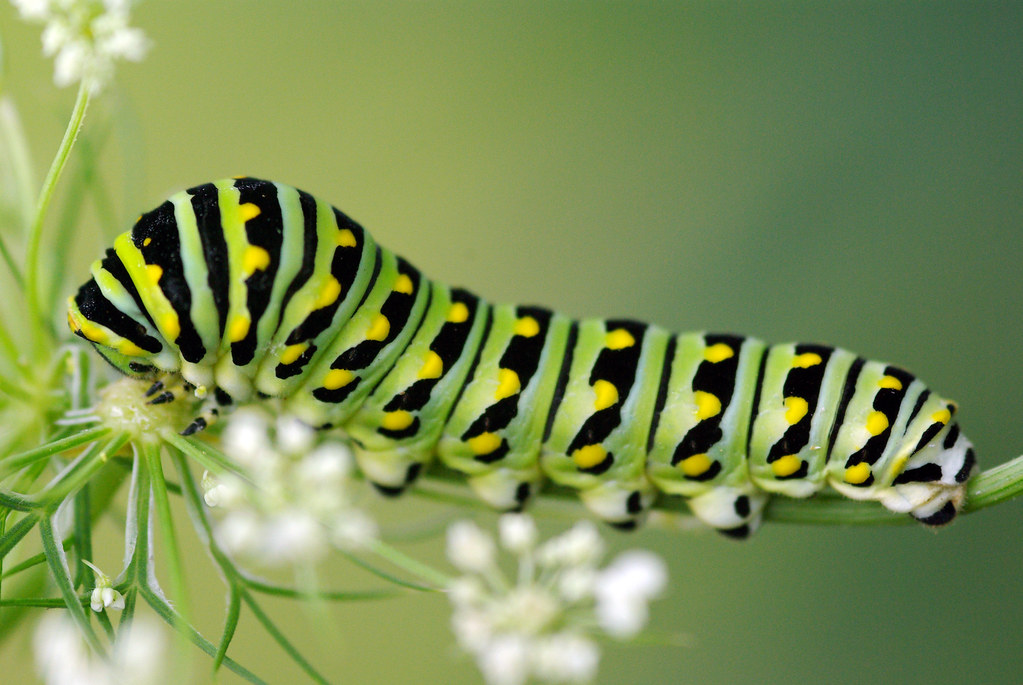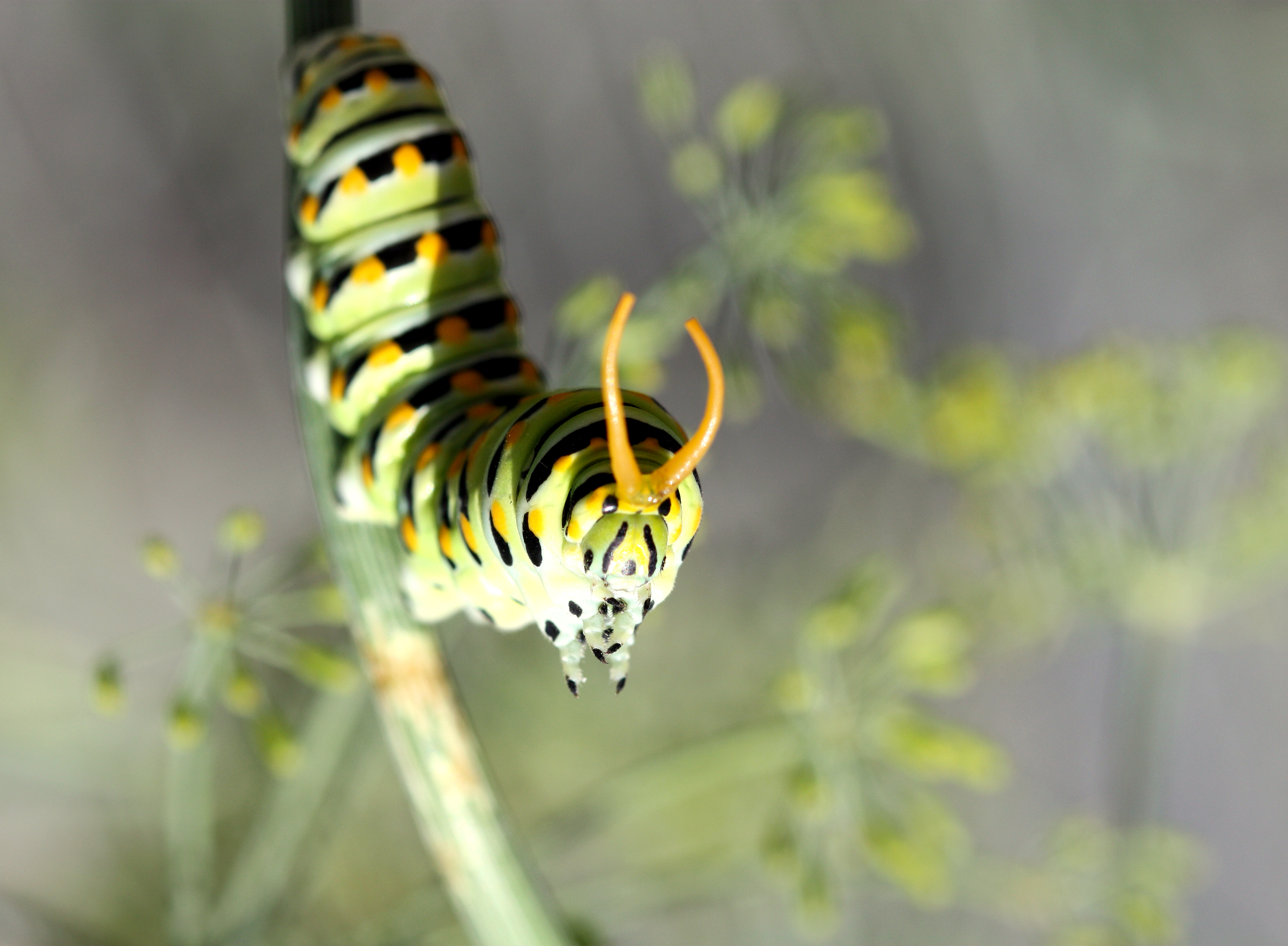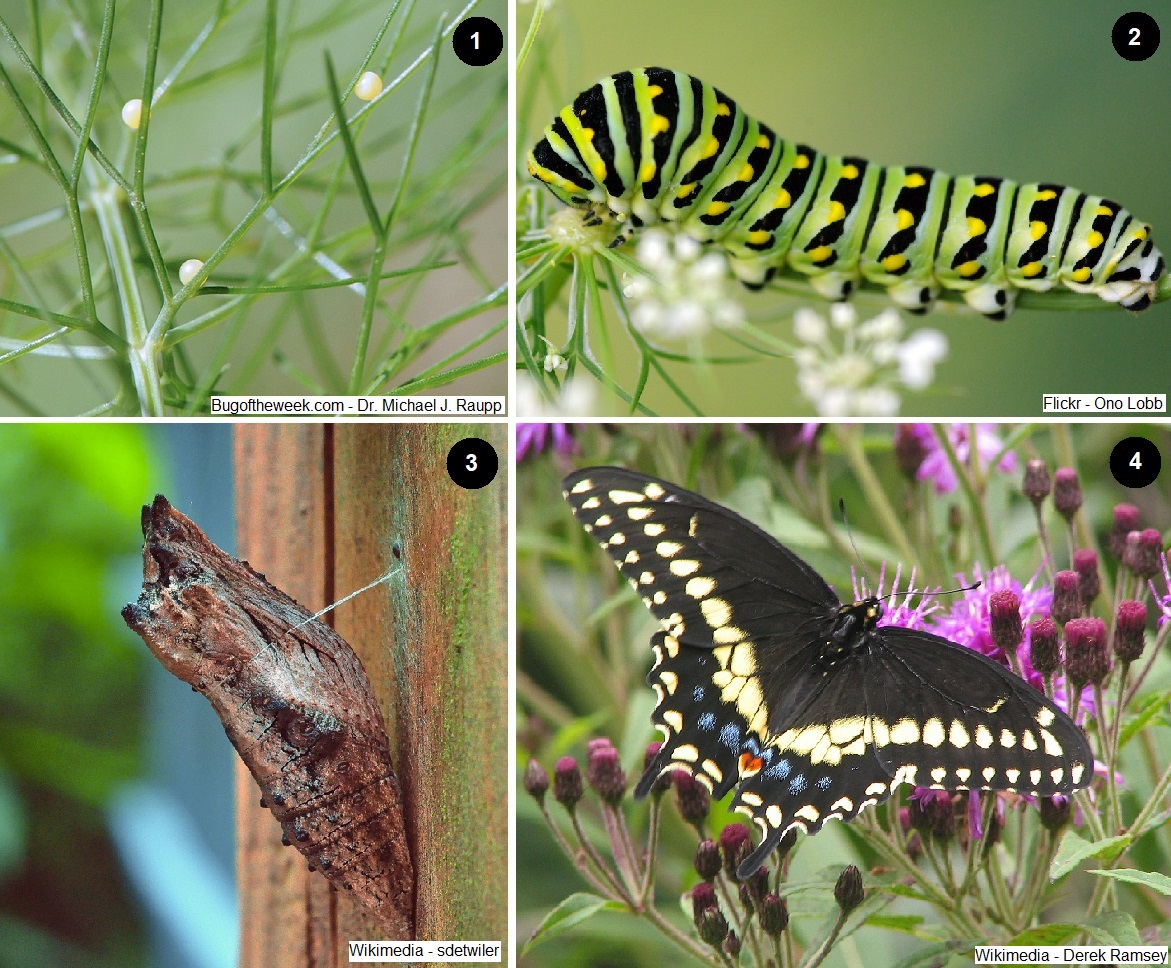Wonders of Wildlife: Black Swallowtail
Black Swallowtail
Scientific Name: Papilio polyxenes
Found in Alabama: Statewide
Diet: Herbivore (eats plants)
Learn more about... |
|
Black Swallowtail Butterfly in Habitat
Paul Brennan
Click image to enlarge it |
| CLASSIFICATION |
|
What type of animal am I?
- I am an invertebrate (an animal without a spine or backbone).
- I am cold-blooded, so I cannot control my body temperature.
- I have a stiff covering on the outside of my body called an exoskeleton.
- I breathe through small holes in my abdomen called spiracles.
- I have six legs.
- I have wings.
|
Scientists use basic traits to group animals into different taxonomic classes.
For a taxonomic classification chart comparing key traits of common backyard wildlife,
CLICK HERE! |
|
| The Black Swallowtail is an INSECT! |
| IDENTIFICATION TIPS |
ADULT BUTTERFLY |
|
Black Swallowtail Butterfly
Wikimedia - Derek Ramsey
Click image to enlarge it
|
- Wingspan ranges from 2.5 - 3.5 inches
|
|
|
- Body is black with rows of white spots
|
- Orange-red eyespot with a center black “pupil” at innermost bottom point of upper side of wings
|
- Underside of top wing has two rows of pale yellow spots
- Underside of lower wing has two rows of orange spots separated by a powder blue color
|
| |
|
MALE
- Rows of yellow spots on upper side of wings are larger and brighter
- Powdery, shiny blue section between those rows of yellow spots is less noticable
|
FEMALE
- Rows of yellow spots on upper side of wings are smaller and duller
- Powdery, shiny blue section between those rows of yellow spots is more noticable
|
Black Swallowtail Male
Wikimedia - D. Gorden, E. Robertson
Click image to enlarge it |
Black Swallowtail Female
Wikimedia - Kenneth Dwain Harrelson
Click image to enlarge it
|
| |
|
EGGS
- About the size of a pinhead
- Round and cream colored
Black Swallowtail Eggs
Bugoftheweek.com - Dr. Michael J. Raupp
Click image to enlarge it
|
CATERPILLAR (LARVAE)
- Up to 1.5 inches in length
- When young, dark brown or black with white "saddle" midway down the body
- When older, bright green with black bands containing white dots
|
CHRYSALIS
- Range from green with yellow markings to brown
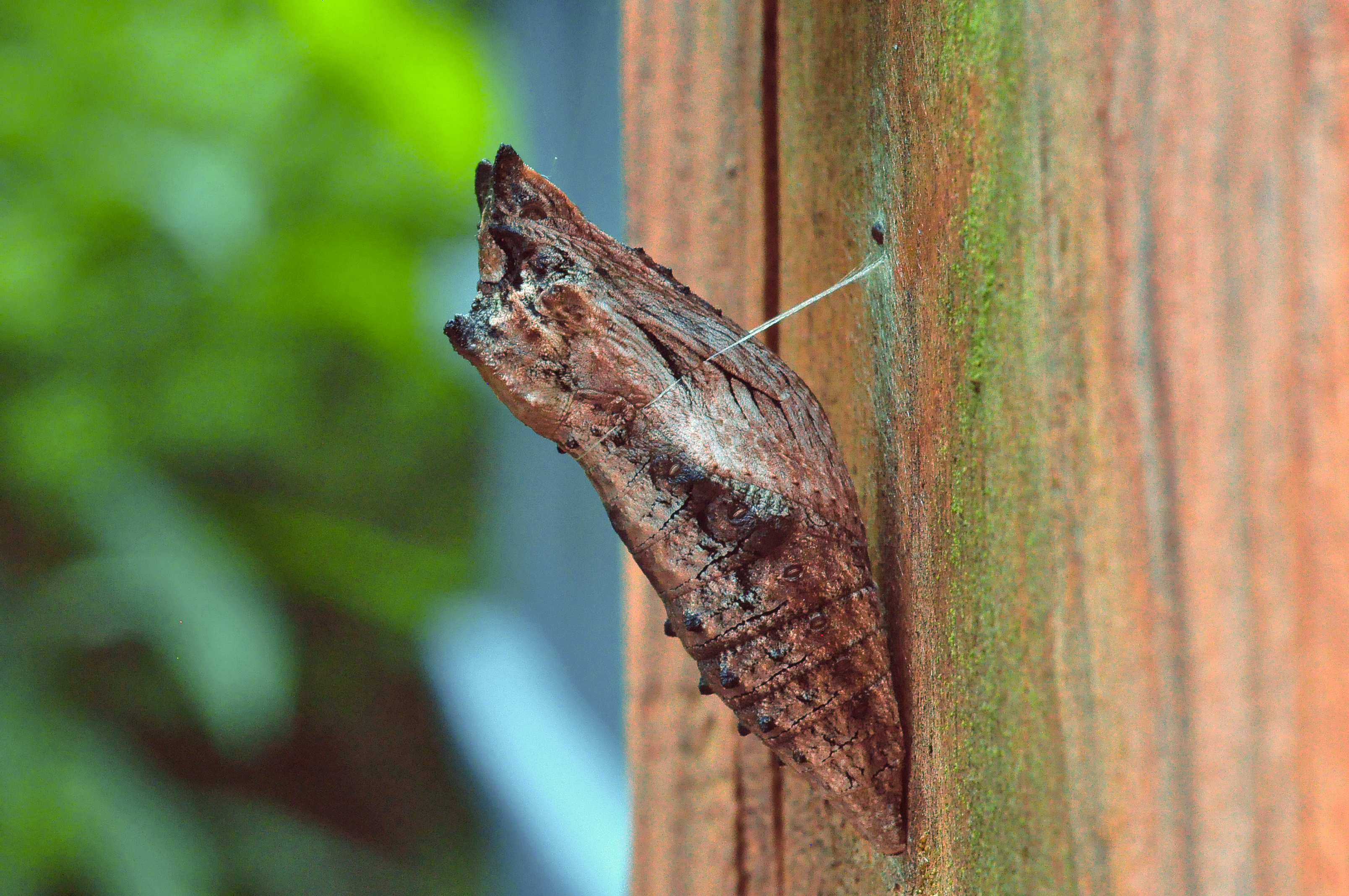
Black Swallowtail Chrysalis
Wikimedia - sdetwiler
Click image to enlarge it
|
Young Black Swallowtail Caterpillar
Flickr - Judy Gallagher
Click image to enlarge it |
Older Black Swallowtail Caterpillar
Flickr - Ono Lobb
Click image to enlarge it |
| ADAPTATIONS |
| |
| PHYSICAL ADAPTATIONS |
| |
| Black swallowtail caterpillars avoid animals that want to eat them: |
- The most basic defense of a blackswallowtail caterpillar is its appearance.
- They resemble bird droppings, making them unappealing to predators (animals that eat them).
- Many of the host plants that they feed on are poisonous, but the caterpillars are resistant to the poisons.
- The toxins (poisons) they ingest when feeding on the host plant make them taste bad to predators.
|
Black Swallowtail Osmeterium
Wikimedia - styler
Click on image to enlarge it
|
- The caterpillars also have an osmeterium, a defense organ that looks like a deeply forked tongue.
- When disturbed, this organ is pushed out of the body and releases a stinky odor to repel predators.
|
| |
| Black swallowtails have long straw-like mouthparts: |
- All butterflies and moths, including swallowtails, have a long straw-shaped mouthpart (similar to a tongue) called a proboscis that they use to collect nectar from flowers.
- The proboscis has two long tubes (like straws) that soak up the nectar deep inside the flower, and then the nectar travels up through the tubes for the butterfly to drink it.
- When the proboscis is not in use, it curls up tightly against the front of the head of the butterfly.
- To see how a proboscis works and to learn why scientists are studying the proboscis, watch Science Nation's 3-minute video.
|
| |
| Butterflies have compound eyes: |
- Butterfly vision is completely different than human vision.
- While humans have the ability to focus on something far away and can see fine details, a butterfly's vision appears blurry to them because they have compound eyes (many individual lenses that combine to form one image).
- Butterflies have special structures that allow them to see different types of light than humans, helping them locate flowers and communicate with each other.
- They are also able to see a more wide view around them rather than just in front of them, allowing them to detect and escape any threats.
|
| |
| BEHAVIORAL ADAPTATIONS |
| |
| Black swallowtails are diurnal: |
- They are active during the day (diurnal).
|
| |
| Black swallowtails are territorial: |
- Male black swallowtails perch and patrol when looking for a mate.
- They defend territories while perching and patroling and change the location of their territory often.
|
| |
| LIFE CYCLE |
| |
Stages of a Black Swallowtail's Life Cycle
Click image to enlarge it |
Metamorphosis is the process of physical change that some animals go through as they transform from a larvae into an adult.
To view the US Fish and Wildlife Service video of a monarch caterpillar changing into its chrysalis form,
CLICK HERE! |
|
| |
| Four life Cycle Stages of the Black Swallowtail |
| |
1. Egg: |
- Females lay a single hard-shelled egg at a time on leaves of their host plant (the carrot/parsley family).
- They lay 30-50 eggs each day, between 200-440 each season.
- A tiny caterpillar (larvae) hatches from its egg 4-9 days later.
|
| |
|
2. Larvae (caterpillar): |
- The baby caterpillar spends 10-30 days eating its host plant and growing.
- When it becomes too large for its skin, it molts (sheds its skin).
- The intervals between molts are called instars.
- Watch this super cool video of a Black Swallowtail molting!
|
| |
|
3. Pupa: |
- The caterpillar pupates (transitions from larva to pupa) in a head-up position.
- Its skin splits, and the green or brown chrysalis (butterfly pupa enclosed in a protective covering) forms.
- Inside the chrysalis, the caterpillar undergoes metamorphosis (physical change from larvae to adult) in about 9-18 days.
|
| |
|
4. Adult: |
- The adult butterfly emerges from the chrysalis, and then sits and waits while its wings to inflate and dry before it can fly away.
|
| |
|
Life Span: |
- The average life span of the adult butterfly is 10-12 days but can live up to 40 days.
|
NATURAL
Habitat Needs |
ADULTS |
YOUNG |
| Food |
- Feed on nectar from a variety of native wildflowers including red clover, milkweed, phlox, and thistle.
|
- Feed exclusively on host plants in the carrot/ parsley family such as parsley, dill, fennel, lovage, rue (citrus), carrots, celery, and Queen Anne’s Lace.
|
| Water |
- Hydration is obtained from nectar that is collected using their long, straw-like mouthparts.
- They will also drink from puddles or mud to get salt and other minerals.
|
- Hydration is obtained through leaves and stems of host plant.
|
| Shelter |
- Black swallowtails can be found in open areas including both upland and wet areas.
- They can be found in habitats includings weedy fields, pastures, roadsides, woodland edges, marshes, and gardens.
- They are rarely seen in deep forests.
|
- Eggs are deposited on the tip of the host plant’s leaf.
- Caterpillars remain on plant until they are ready to undergo metamorphosis (physical change from larva to adult), at which point the chrysalis (butterfly pupa enclosed in a protective covering) hangs under a well-covered area.
|
| Places to Raise Young |
- Females lay eggs on host plants’ leaves.
- Adults do not raise the young, but the plant provides a food source for the caterpillars as soon as they hatch.
|
|
BACKYARD
Habitat Needs |
ADULTS |
YOUNG |
| Food |
- Provide native nectar producing plants such as red clover, milkweed, phlox, and thistle.
|
- Plant host plants from the carrot/ parsley family such as parsley, dill, fennel, lovage, rue (citrus), carrots, celery, and Queen Anne’s Lace.
|
| Water |
- Garden with nectar-producing plants.
- Add puddling stations or a small pond.
|
| Shelter |
- Garden with nectar-producing plants.
|
| Places to Raise Young |
- Plant host plants from the carrot/ parsley family such as parsley, dill, fennel, lovage, rue (citrus), carrots, celery, and Queen Anne’s Lace.
|
|
| ECOLOGICAL ROLE |
| |
|
| Animals play an important ecological role in the health of habitats and ecosystems. |
| |
|
Food Source: |
- Predators (animals that eat them) of the black swallowtail can include centipedes, spiders, mantids, beetles, ants, wasps, toads, frogs, lizards, birds, rodents, and bats.
- Some parasitic (an organism that lives on or inside of another organism and harms it) wasps and flies will use the caterpillars as hosts.
|
| |
|
Pollinator: |
- Adult black swallowtail butterflies serve as pollinators for native wildflowers by transferring pollen among flowers while they are foraging (searching) for nectar.
|
INFORMATION SOURCES FOR THIS SPECIES
|
|
|
|
| |
|
|
|
|
|
|
| |
|
|
|
|
|
|
| |
|
|
|
|
|
Putnam, Patti; Putnam, Milt (1997). North America's Favorite Butterflies.
|
| |
|
|
|
|
|
|
| |
|
|
.



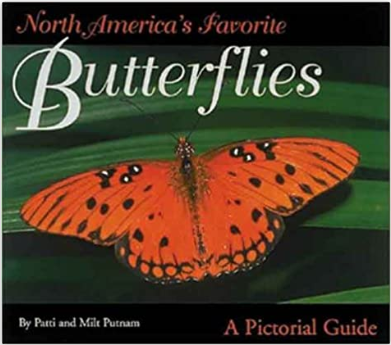


 Wildlife Tag
Wildlife Tag
